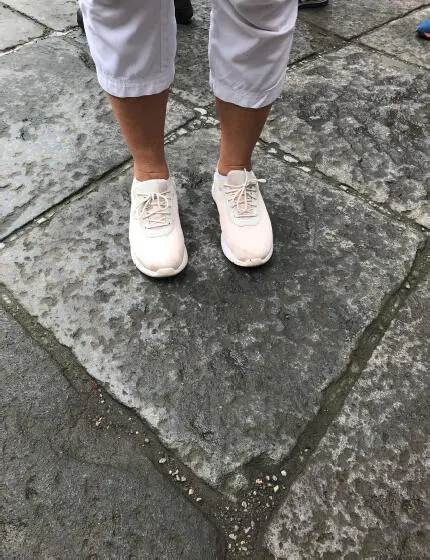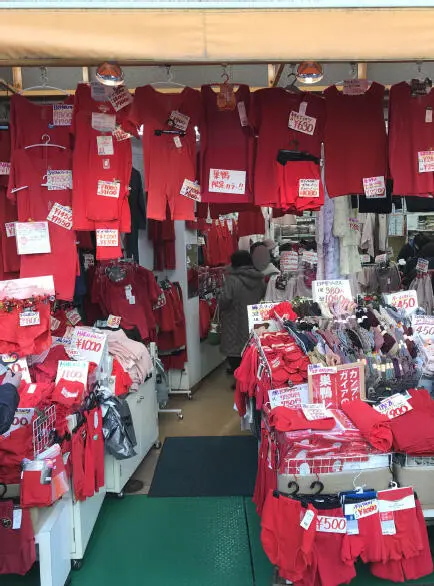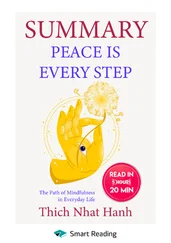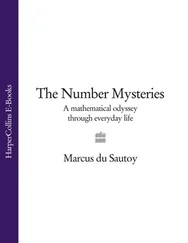The second possibility is, for example, at event locations or in some restaurants, to lock the possibly higher-quality umbrella into a holder, as shown in the photo, and to take the metal key with it. This service is of course free.
The crime rate in Japan is very low and theft is relatively rare. But if the umbrellas are all together in just one large umbrella stand, it can happen that someone simply takes one once it rains. This is not considered a theft, because these cheap umbrellas are usually simply left in a different spot when you no longer need them.
The operator of the DyDo vending machines for drinks came up with the idea to offer such lost-and-found umbrellas from the railways as umbrellas people can rent at many of his vending machines in the event of unexpected rain. Customers are asked to bring the loaned umbrellas back to a vending machine, which, according to company data, actually happens in 70% of the cases - without fees and on a basis of trust.

What is missing in this shop?
There are no employees in this experimental kiosk in a Tokyo train station. Everything happens automatically.
Imagine sleeping in a hotel and suddenly a female voice comes from the dark and asks you how she can help you. At such a moment for sure you immediately wake up in the middle of the night. And yet the communication robot only wanted to reply to your snoring. Welcome to the Henn na Hotel, Youtube: Galileo „Das japanische Roboterhotel“. The concept of this hotel was to have robots fulfill nearly all services. Unfortunately, the robots were annoying due to a number of malfunctions, so that some machines were shut down because guests complained.
The use of supporting technology is tested in many places in Japan and in the illustrated shop, the customers do everything themselves and pay, for example, with the Suica, a prepaid e-money card, almost every Japanese owns anyway. Access is only available if you hold a valid card to a reader. The store itself has dozens of cameras on the ceiling and shelves that record what the customer takes off the shelf. Before leaving the kiosk, the visitor holds his card back to a reader, receives a receipt and leaves the store. At the moment, this kiosk is in a two-month trial period and offers only a relatively small product range. Additionally, six employees explain the process to interested customers. This will surely change soon and little by little people will get used to self-service in supermarkets in Tokyo.
The Japanese economy has grown moderately and steadily for years and this rather unnoticed. Unemployment was recently at 2.2% and there are 163 job offers for 100 job seekers. Many branches of industry have been desperately looking for new workers for years, and today you can see much more foreign employees compared to 10 years earlier especially in small supermarkets and restaurants.
In April 2019, a new law will come into effect to make it easier for foreign workers to come to Japan to work here. In addition to the 1.28 million foreign workers, another 500,000 are to be added. Then the long-standing foreigner share of about 2% would rise somewhat, which does not appease all Japanese and also leads to heated discussions in parliament.
The Japanese have few reservations about using robots, such as exoskeletons, to lift heavy loads, and also in geriatric care, to make work easier.

What is this stone´s meaning?
This is a power spot in Toshogu Shrine in the city of Nikko. There is to be a special power people can feel, through which they can recharge bodily and spiritual energy.
"You need more guests? Then just put something into nature and call it a Powerspot. „The Japanese are crazy about it“ a quote based on the Japanese movie “50 first kisses“.
You do not have time to visit one of these places? No problem! Already a photo of a power spot or a celebrity, such as Miwa Akihiro help to gain more energy. A smartphone owner already has more luck and a better feeling by simply using such a photo as the lock screen.
For many years people in Japan have relied on special places where the visitor is supposed to gain spiritual power. Japanese radio broadcasts, television reports and travel magazines are always providing new clues to mystical places. Many places in nature that have a special atmosphere are considered such places. Above all, of course, Mount Fuji (Fujiyama), other mountains, lakes, waterfalls and forests, but also many temples, such as the Meji Shrine in Tokyo or the aforementioned Toshogu Shrine in Nikko. This shrine is located amidst many old trees, for many visitors this has a very special aura that can certainly help to feel better. True hunters of the Powerspot know, however, that there is still a very special place, namely this stone. The Toshogu shrine was purposely chosen as his tomb by Tokugawa Ieyasu, who has united and pacified Japan. He consulted astrologers and scholars and commanded that his descendants should build a representative shrine here. In order to fulfill Ieyasus’ wish to be able to look on Edo (old name for Tokyo) as the pole star, the main gate was aligned exactly from west to east. The Polaris was considered king of the stars in Asia and stood in their center. Ieyasu drew lines between his birthplace, one of his earliest tombs (his tomb was repeatedly moved), Mount Fuji, Edo Castle, and the place of his burial in Toshogu Shrine. The result was an east-west line and a south-north line, which should extend to the Polaris. The stone is placed exactly where these lines converge. The Japanese stand in line to feel the special power of this place and benefit from the strength of Ieyasu as well as the radiance of the polar star. According to reports, the body should warm up while pausing in this place.

Why does this shop offer a huge selection of red underwear?
When turning sixty Japanese receive a lot of red things, also red underwear, which they are supposed to wear from now on.
Tourists from all over the world visit the Harajuku district of Tokyo to admire the latest youth trends, to eat crepes, to photograph themselves and then share this on social media. Tourists from all over Japan come to the Sugamo district of Tokyo to admire the latest fashion trends for the elderly, to eat delicious plain fare and to buy red underwear. It is just the "Harajuku of the old ladies and gentlemen".
First and foremost, you can buy everything in the same shade of red, from underpants, undershirts, socks to headdresses.
When asked why red underwear and the color red are generally so popular with Japan's retirees, there are several answers. First of all, the color red is simply supposed to bring luck. Some claim that according to Chinese medicine, it is supposed to stimulate an energy point on the navel, which consequently strengthens the circulation and thereby warms the body. Furthermore, the color red also has a psychological effect, the color is supposed to increase wellbeing and gives strength.
In Asian cultural history, explanations for this phenomenon can actually be found. The Japanese are of the opinion that when they turn sixty, their life begins anew, they finds themself in the so-called phase of Kanreki (return to the beginning of the circle). This is explained in the Japanese online lexicon "Wadoku" with the fact that in the Chinese calendar the cycles of ten calendar signs and twelve signs of the zodiac overlap and together restart after sixty years. A sixty-year old starts his life again, like a baby. Akachan (baby) literally translates from the Japanese to little red, which could explain the connection between the color red and the sixtieth birthday. The sixty-year-old traditionally begins a new period of life in which he hands over his family responsibilities to his eldest son and starts a carefree life with less responsibility.
Читать дальше















